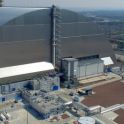News and press releases
GRS seeks to provide clear and careful communication. Our demands on the comprehensibility and quality of information are based on the Guidelines for good science PR.
Steam generator tubes in pressurised water reactors are exposed to high stresses such as high temperatures or large pressure differences. In combination with possible corrosive effects due to deposits in the outer area of the tubes, these stresses can at worst lead to leakages, which in turn could have an influence on operational safety. A team of researchers from GRS and the Materials Testing Institute of the University of Stuttgart has therefore conducted in-depth investigations into such leakages with the support of the Federal Ministry for the Environment and the Federal Ministry of Economic Affairs. The scientists have now developed a flow model with which the leakage rate of the escaping medium can be determined even more precisely than previously possible.
It is unquestionable that a repository for high-level radioactive waste must be safe. This applies both to the phase during which the repository is being constructed and operated and to the phase afterwards, when the waste is enclosed and all drifts and shafts are sealed. In a joint research project, scientists from GRS and BGE Technology GmbH have investigated how these two phases are interrelated and influence each other.
To ensure the safe operation of technical installations such as nuclear power plants (NPPs), it is important to continuously identify and analyse possible risk factors. In addition to technical safety, the so-called human factor, i.e. human influence and contribution, is of crucial importance for the safe operation of installations. Human-organisational aspects are therefore an aspect of safety research that should not be underestimated. In a recent study, GRS scientists have identified organisational factors that can have a negative influence on plant safety. These are specific characteristics that affect the structure of the organisation (organisational structure), the organisation of activities and processes (process organisation), and the corporate culture.
The mineral graphite is used in some types of reactors and can be activated by neutron radiation, i.e. converted into radioactive isotopes. In order to select a suitable disposal option, the graphite must be thoroughly examined radiologically. However, many measuring methods are relatively costly and in turn produce new radioactive waste themselves. A team of researchers from GRS and the University of Cologne is therefore developing a method with which reactor graphite can be characterised quickly and reliably.
Researchers worldwide are working on small modular reactors (SMR) and microreactors (very small modular reactor, vSMR). Many of these new reactor concepts are being developed for specific applications and have special core geometries. In order to be able to simulate the neutron-physical behaviour of these cores, GRS is developing the simulation code FENNECS (Finite ElemeNt NEutroniCS).
In a repository, geotechnical barriers contribute to the safe and long-term isolation of radioactive waste in the deep underground. The "sandwich" sealing system with its alternating sequence of sealing and filter segments is currently being tested as a geotechnical barrier in a large-scale experiment. GRS has assumed the technical leadership of the project at the international Mont Terri rock laboratory.

A good ten years after the nuclear accident in Fukushima, the nuclear phase-out in Germany is about to be completed: Three plants will be finally taken off the grid this year, the last three by the end of next year. But nuclear power plants (NPPs) are by no means shut down everywhere – around the world, very different paths are followed with regard to the use of nuclear energy for electricity generation.

26 April marks the 35th anniversary of the Chernobyl nuclear disaster: During an experiment, the power of the reactor in Unit 4 increased excessively due to a series of operating errors, and the fuel and coolant overheated.

In the current Covid 19 pandemic, airborne aerosols that contain viruses are considered to be an important transmission route, especially in insufficiently ventilated rooms. To be able to make a sound assessment of the related risk of infection and to derive appropriate recommendations for action, the aerosol behaviour as well as representative ambient conditions must be considered in detail and realistically. Within the framework of the AeroCoV research project, scientists of GRS have applied the COCOSYS simulation code – which was developed and validated for the analysis of accidents and severe accidents in containments of nuclear power plants – for the first time for calculating the dispersion of SARS-CoV-2 aerosols. The related research report has now been published (download on the right side).

Sound knowledge about the origin, spread and prevention of fires is essential to be able to assess and improve the fire safety of, among others, nuclear power plants (NPPs). Therefore, GRS continuously participates in research projects on the topic of fire protection in nuclear facilities which are conducted under the auspices of the OECD Nuclear Energy Agency (NEA).